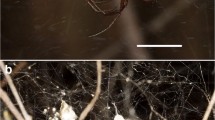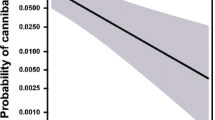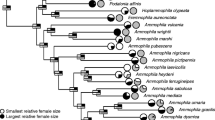Abstract
The evolution of sexual cannibalism as the most extreme form of nuptial feeding is still poorly understood. Although increasing evidence suggests that female aggressiveness is related to other aspects of foraging behaviour, it is not clear whether the nutritional value of a male is sufficient to provide an adaptive significance for sexual cannibalism. A widely cited though rarely tested explanation is based on a paternal investment model, and predicts that consumption of a male results in increased female fecundity. The available evidence is either correlational or restricted to species with relatively large and potentially nutritious males, and different studies have come to different conclusions. Here we present a test of the paternal investment hypothesis using the very cannibalistic and highly size-dimorphic spider Argiope bruennichi. After a preset schedule, we had females consume none, one or two males independent of the female's cannibalistic behaviour. Consumption of male bodies did not result in any detectable fitness benefit for the female: neither the number of clutches, nor clutch size or hatching success were affected by consumption of males. The frequency of cannibalism was around 80%, independent of the female mating status. We did not observe male complicity, but cannibalism was associated with prolonged copulation. This suggests a sexually selected benefit of cannibalism for males. We conclude that the paternal investment hypothesis does not explain the existence of sexual cannibalism in A. bruennichi and probably not in other spider species with a pronounced sexual size dimorphism.


Similar content being viewed by others
References
Andrade MBC (1996) Sexual selection for male sacrifice in the Australian redback spider. Science 271:70–72
Andrade MBC (1998) Female hunger can explain variation in cannibalistic behavior despite male sacrifice in redback spiders. Behav Ecol 9:33–42
Andrade MBC, Banta EM (2002) Value of male remating and functional sterility in redback spiders. Anim Behav 63:670–857
Arnqvist G, Henriksson S (1997) Sexual cannibalism in the fishing spider and a model for the evolution of sexual cannibalism based on genetic constraints. Evol Ecol 11:255–273
Birkhead TR, Lee KE, Young P (1988) Sexual cannibalism in the praying mantis Hierodula membranacea. Behaviour 106:112–118
Buskirk RE, Frohlich C, Ross KG (1984) The natural selection of sexual cannibalism. Am Nat 123:612–625
Eggert AK, Sakaluk SK (1994) Sexual cannibalism and its relation to male mating success in sagebrush crickets, Cyphoderris strepitans (Haglidae, Orthoptera). Anim Behav 47:1171–1177
Elgar MA (1992) Sexual cannibalism in spiders and other invertebrates. In: Elgar MA, Crespi BJ (eds) Cannibalism: ecology and evolution among diverse taxa. Oxford University Press, Oxford, pp 129–156
Elgar MA (1998) Sperm competition and sexual selection in spiders and other arachnids. In: Birkhead TR, Møller AP (eds) Sperm competition and sexual selection. Academic, San Diego, pp 307–339
Elgar MA, Nash DR (1988) Sexual cannibalism in the garden spider Araneus diadematus. Anim Behav 36:1511–1517
Fahey BF, Elgar MA (1997) Sexual cohabitation as mate-guarding in the leaf-curling spider Phonognatha graeffei Keyserling (Araneoidea, Araneae). Behav Ecol Sociobiol 40:127–133
Forster LM (1992) The stereotyped behaviour of sexual cannibalism in Latrodectus hasselti, Thorell (Araneae: Theridiidae), the Australian redback spider. Aust J Zool 40:1–11
Herberstein ME, Schneider JM, Elgar MA (2002) Cost of courtship and mating in a sexually cannibalistic orb-web spider: female mating strategies and their consequences for males. Behav Ecol Sociobiol 51:440–446
Johnson CW (2001) Sexual cannibalism in fishing spiders (Dolomedes triton): an evaluation of two explanations for female aggression towards potential mates. Anim Behav 61:905–914
Lamprecht J (1992) Biologische Forschung von der Planung bis zur Publikation. Parey, Berlin
Levi HW (1975) Mating behavior and presence of embolus cap in male Araneidae. In: Proceedings of the 6th International Arachnology Congress 1974
Maxwell MR (2000) Does a single meal affect female reproductive output in the sexually cannibalistic praying mantid Iris oratoria? Ecol Entomol 25:54–62
Newman JA, Elgar MA (1991) Sexual cannibalism in orb-weaving spiders: an economic model. Am Nat 138:1372–1395
Parker GA (1979) Sexual selection and sexual conflict. In: Blum MS, Blum NA (eds) Sexual selection and reproductive competition in insects. Academic, London, pp 123–166
Sasaki T, Iwahashi O (1995) Sexual cannibalism in an orb-weaving spider Argiope aemula. Anim Behav 49:1119–1121
Sauer KP, Lubjuhn T, Sindern J, Kullmann H, Kurtz J, Epplen C, Epplen JT (1998) Mating system and sexual selection in the scorpionfly Panorpa vulgaris (Mecoptera: Panorpidae). Naturwissenschaften 85:219–228
Schneider JM, Elgar MA (2001) Sexual cannibalism and sperm competition in the golden orb-web spider Nephila plumipes (Araneoidea): female and male perspectives. Behav Ecol 12:547–552
Schneider JM, Elgar MA (2002) Sexual cannibalism in Nephila plumipes as a consequence of female life history strategies. J Evol Biol 15:84–91
Schneider JM, Herberstein ME, De Crespigny FC, Ramamurthy S, Elgar MA (2000) Sperm competition and small size advantage for males of the golden orb-web spider Nephila edulis. J Evol Biol 13:939–946
Schneider JM, Thomas ML, Elgar MA (2001) Ectomised conductors in the golden orb-web spider Nephila plumipes (Araneoidea): a male adaptation to sexual conflict? Behav Ecol Sociobiol 49:410–415
Simmons LW, Parker GA (1989) Nuptial feeding in insects: mating effort versus paternal investment. Ethology 81:332–343
Stålhandske P (2001) Nuptial gift in the spider Pisaura mirabilis maintained by sexual selection. Behav Ecol 12:691–697
Vahed K (1998) The function of nuptial feeding in insects: a review of empirical studies. Biol Rev 73:43–78
Acknowledgements
We thank M.A. Elgar, L.W. Simmons and three anonymous referees for helpful comments on the manuscript. The study was funded by the Deutsche Forschungsgemeinschaft (Schn/561). We declare that the experiments comply with the current laws of Germany.
Author information
Authors and Affiliations
Corresponding author
Additional information
Communicated by L. Simmons
Rights and permissions
About this article
Cite this article
Fromhage, L., Uhl, G. & Schneider, J.M. Fitness consequences of sexual cannibalism in female Argiope bruennichi . Behav Ecol Sociobiol 55, 60–64 (2003). https://doi.org/10.1007/s00265-003-0656-6
Received:
Revised:
Accepted:
Published:
Issue Date:
DOI: https://doi.org/10.1007/s00265-003-0656-6




